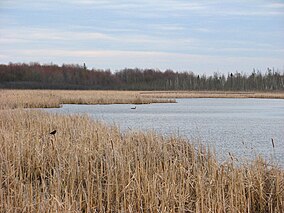| Mer Bleue Bog | |
|---|---|
 Pond with part of boardwalk in background | |
| Location | Eastern Ontario, Canada |
| Nearest city | Ottawa |
| Coordinates | 45°24′N 75°30′W / 45.400°N 75.500°W |
| Area | 3,343 ha (12.91 sq mi) |
| Established | Ramsar 5 Oct. 1995 |
| Governing body | National Capital Commission |
| Official name | Mer Bleue Conservation Area |
| Designated | 26 September 1995 |
| Reference no. | 755[2] |

Mer Bleue Bog is a 33.43 km2 (12.91 sq mi) protected area in Gloucester, Ontario, an eastern suburb of Ottawa in Eastern Ontario, Canada. Its main feature is a sphagnum bog that is situated in an ancient channel of the Ottawa River and is a remarkable boreal-like ecosystem normally not found this far south. Stunted black spruce, tamarack, bog rosemary, blueberry, and cottongrass are some of the unusual species that have adapted to the acidic waters of the bog.
The area provides habitat for many species, including beaver, muskrat, waterfowl, and the rare spotted turtle (Clemmys guttata). A 1.2 km (¾ mile) boardwalk allows visitors to explore a section of the bog. There are hiking trails that follow raised areas along the edges of the bog and cross-country skiing trails for use in winter. The conservation area is managed by the National Capital Commission.
The value of this unique wetland was not always recognized. During World War II, the Royal Canadian Air Force used this area for bombing practice. Now, this area has been designated as a Ramsar site, a Wetland of International Significance under the Ramsar Convention since October 1995, and an Area of Natural and Scientific Interest since 2011.[3]
The name "Mer Bleue" (French, meaning "blue sea") is thought to describe the bog's appearance when it is covered in morning fog.
- ^ "Mer Bleue Bog". Protected Planet. United Nations Environment World Conservation Monitoring Centre. Retrieved 11 May 2020.
- ^ "Mer Bleue Conservation Area". Ramsar Sites Information Service. Retrieved 25 April 2018.
- ^ "Areas of Natural and Scientific Interest (ANSI)". geohub.lio.gov.on.ca. Retrieved 27 April 2020.
